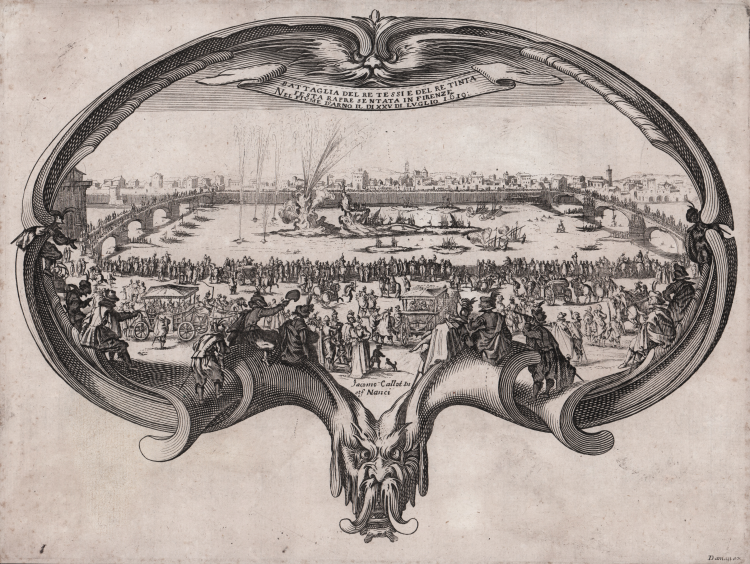




| Reference: | S41412 |
| Author | Anonimo - Scuola Italiana |
| Year: | 1620 ca. |
| Measures: | 303 x 230 mm |



| Reference: | S41412 |
| Author | Anonimo - Scuola Italiana |
| Year: | 1620 ca. |
| Measures: | 303 x 230 mm |
Etching and engraving, signed in plate in lower center "Jacomo Callot In et f Nanci." At lower right, in the white margin, the imprint "Daman ex."
Magnificent proof, richly toned, printed on contemporary laid paper, trimmed to the copperplate, in excellent condition.
This is a counterpart copy of the famous engraving by Jacques Callot known as L'Éventail, due to the type of the form. Example in the probable second state of three, with Daman's address and before the address in Bassano for the Remondini.
The engraving depicts the mock naval battle between weavers and dyers, executed on the Arno, in Florence, on the evening of July 25, 1619. It shows the Arno between Ponte alla Carraia and Ponte a Santa Trinità, with a vast view of Florence in the background. Frigates fire at each other before a fireworks display. The view of the festival is enclosed in a scroll whose shape resembles that of Florentine fans. Several figures stand or sit on the scrolls that adorn the scroll; one watches the show through a telescope.
Jacques Callot's rostral (from the type of shape) or fan represents one of the staples in the history not only of the fan but also of Florence. Its shape is definitely beautiful, typical of the taste of the early 17th century. Those who "clash" in the goliardic battle are actually weavers and dyers. On that occasion the contention was actually discursive, and focused on the exchange of speeches, directed toward each other, having for subject matter poems specially composed by Andrea Salvadori, while the practical organization was due to Giulio Parigi. Note, on the left side, a character holding the very fan that is the subject of the engraving.
In the Malmantile racquistato, a famous heroicomic poem by the painter writers Lorenzo Lippi (Florence, 1606-1664), this event is punctually described: “D'altra solenne festa, fatta dalle due Potenze de' Tessitori e de' Tintori, si trova stampata sotto questo titolo […] Alle "Stelle Medicee" v'è l'argomento in prosa, l'introduzione in un Madrigale e ventidue Ottave sopra la disfida. Queste ottave sono di Andrea Salvadori. Furono prima stampate in un cartello e poi in una rosta nella parte anteriore della quale si vedeva la rappresentazione di questa festa, intagliata in rame dal rinomatissimo Jacopo Callotti”.
From this contemporary account, Lippi's work was published posthumously in 1676, we infer that the engraving was made in pendant with Salvadori's verses.
Judging by the large number of contemporary copies - Lieure describes as many as 6 - the work was a huge success. The present example, with imprint by the unknown publisher Daman, is described by Lieure - who, however, knows of only the reprint published by Remondini in Bassano.
Daman was a print publisher, active in Bologna and Paris in the 17th century, whose name (but never initial or address) appears on reprints of engravings by Biscaino, Grimaldi and other artists. Traditionally it has been assumed that he was Italian but, judging from the series of engravings of Perelle and Borbone that he published under French privilege, he must have worked in Paris in the 1640s, which does not rule out a possible Italian birth and a period of work in Italy. Biscaino died of the plague in Genoa in 1657, at the age of 25, and Daman must have acquired his plates shortly thereafter. Mariette (Abecedario I 132) notes that they were rare and has no idea what became of the plates. At least part of Daman's stock was later acquired and reprinted by the Remondini (see Giorgio Marini in 1990, cat. Remondini, p.257).
Although it lacks a watermark, the paper on which the work is printed definitely looks to us like an Italian paper from the first half of the 17th century. We speculate on the existence of an early issue of the plate, ahead of Daman's address.
Bibliografia
Lieure 302, copy 6, I/II.
Anonimo - Scuola Italiana
Anonimo - Scuola Italiana